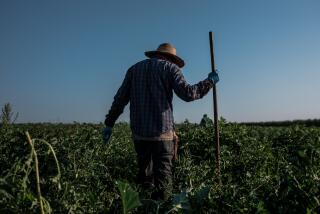U.S. Seeks to Rescue Farm Credit District in Midwest
WASHINGTON — The federal Farm Credit Administration, regulatory agency for the nation’s largest farm-lending system, has proposed a $435-million plan to bail out the system’s troubled four-state district based in Omaha.
The rescue plan for the Omaha Intermediate Credit Bank is similar to a $150-million package approved a month ago to help the farm credit bank in Spokane, Wash.
The bail-out efforts underscore the continuing economic stress in the farm belt as crop prices fall and exports dwindle. The Farm Credit System, a quasi-governmental network of banks owned by the farmers who borrow from it, holds about $80 billion of the nation’s $212 billion of farm debt.
Kim Bowersox, a spokesman for the Farm Credit Administration, said Monday that the latest bail-out plan calls for Omaha Intermediate Credit Bank and its production credit associations--the local lending outlets for the bank--to absorb $95 million in losses from existing reserves. Meanwhile, the 36 other regional banks in the system would contribute $75 million to the Omaha bank in loss-sharing payments.
In addition, late this year or early in 1986, the Farm Credit System Capital Corp. would buy and service $240 million in high-risk loans from the Omaha bank and its production credit associations. The corporation is a new entity, funded by all 37 banks in the system, that was set up to take similar steps in the case of the Spokane district.
The proposed plan also would give the Omaha bank access to another $25 million to cover future operating losses. Moreover, it would continue a consolidation of the district’s production credit associations, putting them under closer scrutiny of a central office in Omaha.
Approval of the rescue plan by the governing boards of the 37 regional banks is expected by Sept. 1.
The Omaha bank currently holds about $1.6 billion in short-term operating loans to 19,000 farmers and ranchers in Iowa, Nebraska, South Dakota and Wyoming.
“These states are among the hardest hit by the stress in the agricultural economy,” Bowersox said.
Farmers in the region are heavily reliant on grain prices, which remain in a long-term slump, and they have suffered steep declines in the value of farm land, the collateral for most farm loans.
The Farm Credit System was created early this century to help provide financing for farmers having difficulty getting loans through usual commercial channels.
More to Read
Sign up for Essential California
The most important California stories and recommendations in your inbox every morning.
You may occasionally receive promotional content from the Los Angeles Times.










